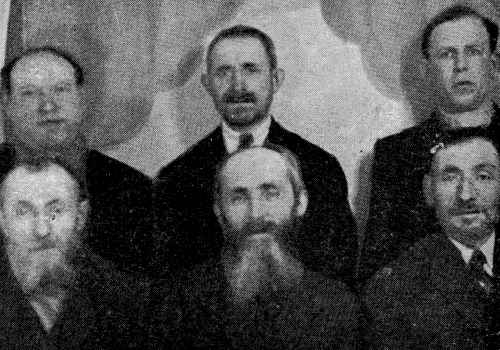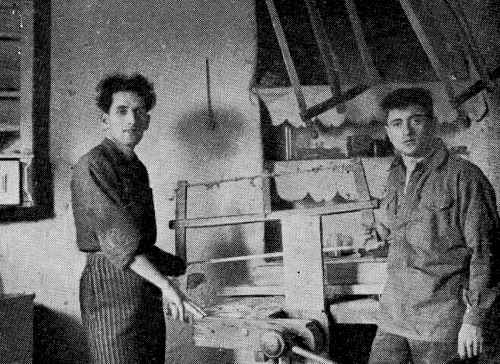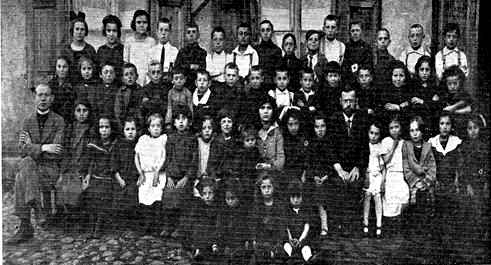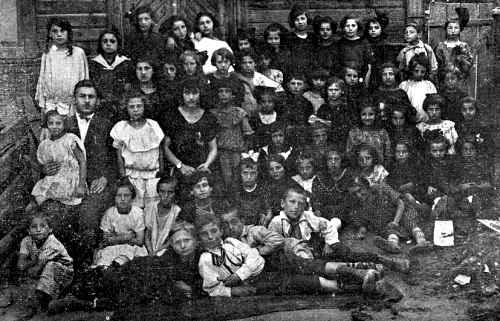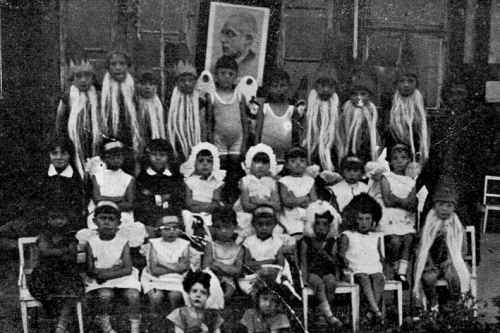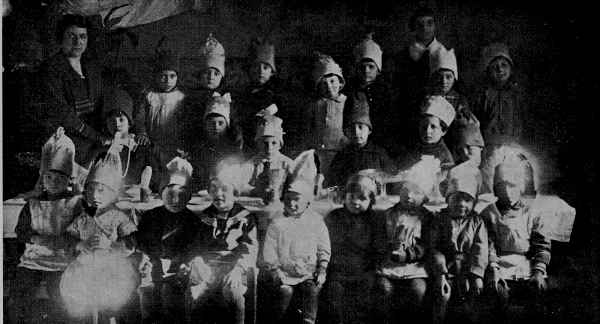[Page 113]
Occupations of the Jews of Kałuszyn[1]
By Yitzchok Minski / Ramat Yitzchak (Israel)
Translated by Gooter Goldberg
The figures provided here are not the result of accurate scientific research but are rather based on my memory and knowledge of the town's circumstances. I also consulted Kałuszyn Jews of many professions in order to create a more or less accurate picture of the occupations of the town's Jews during the years 1928-29, when the general crisis has left its imprint on the existential anxieties of the people.
Leather Products
Shoemakers – Supplied leather to subcontractors for the production of boots and sold the finished goods at markets – four persons; manufactured the boots themselves and sold at markets – ten persons; manufactured the goods themselves and sold wholesale to traders – five people; six persons were making children's shoes; self-employed home-workers producing for traders only – twelve persons; fifteen workshops were making to order; ladies' shoes were produced by ten people; shops selling all sorts of ready-made shoe wear – six; krak(e)s[2] and slippers – produced by six persons.
Shoe-uppers makers – made for job-lines – four persons; makers to order – seven people; ladies' shoes – seven people.
Apprentices - shoe workshops employed fifteen persons; apprenticed to shoe-upper makers were twenty-five persons (a lot of auxiliary work was performed by the worker's/manufacturer's own children).
|
|
| Leading members of the Artisans Union |
Wood Products
Turners – there were thirty self-employed assisted by fifty apprentices/employees. They produced: chess sets, ternes[3], (smoking) pipes, handles for utensils, table-legs, dolls and toys. Many used children to operate the primitive drives that turned the lathes. After 1928 people started using electrically operated machines. In the thirties the trade experienced a boom thanks to the invention of the “yo-yo”. Traders from Warsaw used to wait at the machines to “grab” any quantity of finished toys.
Furniture makers – there were fifteen employers, ten employees and a lot of assistance work rendered by the employers' own children. They produced furniture for town dwellers as well as for the better-off peasants from around the area.
Shinglers – there were ten self-employed and twenty employees. They used to cover roofs in town and in the environs. Even for this type of work small children were used.
Building carpenters – (made doors and windows for buildings) – four persons.
Masons – three self-employed engaged mainly in building heating-ovens in dwellings and installing various built-in appliances (the latter - also made from timber).
|
|
A carpentry workshop
Yedvab and Driter (on the left - G.G.) |
Tailors
Makers of job-lines – there were twenty persons; bespoke tailors – five. There were two makers of greatcoats and costumes; five of ladies garments; three of linen and bridal outfits; four of dressing gowns and split cloaks; four employed in alterations and makeovers.
Other occupations:
Hatters – ten;
Rope making – three families, mainly on order from the peasants in the area;
Tinsmiths – three persons – produced various utensils and roof guttering;
Saddlers – six – made harnesses and repaired saddles for coachmen and peasants;
Bakers – seven – baked for the town and also hawked baker's wares in the area;
Barbers/Hairdressers – seven; their children continued in the trade;
Blacksmiths – five – looked after horse and wagon at the town's rogatke[4];
Carriers/porters – fifteen – mainly elderly persons – with great effort lugged heavy sacks until finally could afford horse and cart - a considerable improvement;
Coachmen – six – used to take people to the railway station at Mrozy[5];
Drivers – carting produce and wares to Warsaw – ten;
Dealers in rags – ten; the collected rags were transported to Bialystock and Lodz;
Potters – twenty-eight; all were employed in the (town's) pottery, where only two non-Jews were working;
Butchers – a few dozen families with a lot of helpers - at the meat-shop section in the market square;
Housepainters – three; they were mainly busy before holidays;
Klezmers[6] – They were an entire family engaged in this type of music-making both as an avocation, as well as an occupation; they were renowned in town and the surrounding area, also in Warsaw;
Feldshers[7] – two – served the town and the peasants in the area; they had the reputation of doctors;
Photographer – only one; he was in step with the young people and the social life in town; wherever an event or activity – a snapshot;
Watchmakers – these “clock-work experts” were also knowledgeable in world affairs and their shops were centres of news and politics…
Larger workshops and small factories
The well-known Kałuszyn occupation – talaysim[8] –making kept busy twenty master- weavers and sixty employees (well organized by Poalei Tsiyon[9]); the two large mills in town were owned by Dovid Ruzhe and Peretz;
Pelisse factories – Berman's and Gozhik – employed a few dozen families – supplied the army and the tramways.
There were also small workshops which employed twenty girls and some out-workers producing fly-paper and adhesive paper; a workshop of small boxes; a workshop of cigarettes; a factory of soda-water; and about five small brush factories, where every fortnight the workers would go out on strike and whose owners were as “rich” as their employees.
Commerce
In the commercial sector there was a continuous struggle for a living and against the plague of taxes and Jew-baiting. With astuteness people tried to get around all the problems.
The dealers in all sorts of cheap and second-hand goods used together to hire horse and cart, take along their wives and children, “arm” themselves with talis and tfillin[10] and set out (to vend their goods) – thus in summer and so in winter. Half frozen they used to arrive in a (Jewish) settlement, warm up a bit at an open fire, first do the prayers and then start the day of haggling – slapping palm against palm: give a złoty[11], take a złoty, and… at times there was not even a “starter”, and no money to pay the fare.
The same artisans and traders used to go to Warsaw to buy merchandise with only two zlotys in pocket and try to buy on “open”[12] or for bills of exchange, hoping for sale realizations (in cash). Many a time, however, they were forced to take out a loan to cover the cost of the trip home.
Many artisans had to supplement their income by extra activities: the saddlers kept goats; others used to try to become “orchardists” - leasing a few trees in a village, spend the summer there with wife and kids and looked upon each fruit as a miracle…
On all the wagons on which Jews used to wobble carting the few wares to Warsaw they trembled in fear of the “Milosne bandits”[13]. If one's luck ran out – one returned home “b'dili-dal”[14].
And then there were also the “merchants” within the town's precinct: the “spotholders”[15], mainly elderly women, burnt by the sun in summer and by frost in winter, sitting over firepots[16]; the fish vendors – about seven families who depended on subsistence on the one day of the week - Friday; the people manning the stalls after wandering from market to market, forever waiting for a customer; the grain merchants who used to send out “scouts” on the roads to pick up a peasant with horse and cart and a sack of grain to lead him straight to a buyer. There were the timber merchants (five families) in the forests always in fear of brigands; and the talaysim vendors always roaming the district away from home and estranged from their own children – all this rolled into one tangled ball of misery and worry over a day's sustenance.
Translator's Footnotes
- This is an unedited translation from Yiddish of די פּרנסות פֿון קאַלושינער ייִדן, an article in “Sefer Kalushin”, Published by the “Kalushiner Societies in Israel, the United States of America, Argentine, France and other countries”, Tel-Aviv, 1961. Return
- Unable to find a translation. Could be sandals or clogs? Return
- No translation found. Could be a game? Return
- Field-gate, barrier. Return
- The train passed through neighbouring Mrozy, but not Kałuszyn. Return
- Klezmer (from Yiddish כּלי־זמיר, kley - instrument and zemer - song; etymologically from Hebrew k'li zemer כלי זמר, “musical instrument”) is a musical tradition which parallels Chassidic Judaism. Around the 15th century, a tradition of secular (non-liturgical) Jewish music was developed by musicians called klezmorim (klezmers). The repertoire is largely dance songs for weddings and other celebrations. Due to the East and Central European lineage of this music, the lyrics, terminology and song titles are typically in Yiddish. (Based on Wikipedia). Return
- Feldsher - Old time barber-surgeon (Weinreich's); not fully-qualified physician in Eastern Europe (from German Feldscher – army medic, doctor's assistant). Return
- Talaysim (talitim) - prayer shawls (singular tales or talit). Return
- Labour Zionists. Return
- Tefillin (Heb. תּפֿלין; usually translated “phylacteries”; sing. tefillah), two black leather boxes containing scriptural passages which are bound by black leather straps on the left hand and on the head and worn for the morning services on all days of the year except Sabbaths and scriptural holy days.(Encyc.Judaica). Return
- Literally - “golden”, Polish monetary unit. Return
- Sale or return. Return
- Miłosna – a town between Minsk-Mazovyetsk and Warsaw. Return
- “In great poverty”. Return
- Taking up (any) position at the market. Return
- Pots filled with hot coals kept under the stool - all covered by the anklelength skirts. Return
[Page 118]
The First Hebrew School[1]
By Simcha Sitin / Yaffo
Translated by Gooter Goldberg
|
|
| The “Tarbut” school and the teachers Furmanski and Yechiel Shpantzer |
In 1916 a number of Kałuszyn Zionists got together and decided to establish a Hebrew school – Beit Sefer “Tarbut”[2]. The group consisted of the comrades Mordechai Kuski, Laybl Rozenfeld, Yankev Goldberg, Shmul Solman, Yosef Yavorski, the brothers Felner, Gershon Henich, Yisroel Manchemer and my father Dovid Sitin.
The first students of the school were the children of the founders. A teacher, Huberman was brought in from another town. Without delay he started to speak to us in Hebrew. It all began with a blessing: “shalom” (peace unto you); a question: “mah shlomcha” (how are you?); and a song: “cheder katan tzar uchamim, al hakira - ash (a small room, narrow and cozy, in the heater a fire {is burning}). With these words and little song we waded into learning and singing – all in Hebrew.
We were not aware then that these few Hebrew words, which we heard for the first time in our lives, would have such an influence on our young minds and our subsequent way of life. We didn't know then that we, four and five-year old kids, the first pupils of the Hebrew school in Kałuszyn would later become the pioneers of the Chalutz [3] movement in our town and become olim [4] and builders of the Land of Israel.
We imbibed in the school the spirit of Eretz Israel[5]. That was what our parents as Zionists, as lovers of the land, aimed at. However, many of them (later) regretted and suffered from our Hebraist education, which on the one hand gave them much joy, but on the other took us on a different path, one which was liable to alienate us from them. When they discovered that we youngsters grew up and chose the path of Chalutzism, it was already too late and more than one regretted sending his child to a Hebrew school.
This caused many a drama in our homes, but no one could divert us from our road any more. The Hebrew language was the seed which caused to blossom the dream of the Land of Israel. The letters and words led to deeds.
What a pity that not all of us lived to see the realization of that dream!
Translator's Footnotes
- This is an unedited translation from Yiddish of די ערשטע העברעישע שול, an article in “Sefer Kalushin”, Published by the “Kalushiner Societies in Israel, the United States of America, Argentine, France and other countries”, Tel-Aviv, 1961. Return
- The Tarbut movement was a network of secular, Hebrew-language schools in Poland, Romania and Lithuania between World War One and Two. (Based on Wikipedia). Return
- Chalutz or Halutz - (Hebrew) - Pioneer or scout. In Zionism, those who settled in rural areas, drained swamps and built the land (http://www.zionism-israel.com/dic/Halutz.htm). Return
- Someone who “makes aliyah” is called an oleh (m) or olah (f), the plural for both is olim. Aliyah (“ascent”) refers to Jewish immigration to the Land of Israel and since its establishment in 1948, the State of Israel. (Based on Wikipedia). Return
- The Land of Israel. Return
[Page 119]
Jewish Youth in the Polish (State) Schools[1]
By Pola Kaplan / Tel-Aviv
Translated by Gooter Goldberg
Within the school we were taught that there is one law for all and that all citizens are equal. However, at every step we took outside the school we were instantly confronted by hate. Full of hatred were also the Christian youths with whom we were studying together. They pelted us with stones and were quite generous with verbal abuse. Complaints to the principal were of no use whatsoever.
Already then we were asking ourselves whether we'd be able to live and build our future in such a poisoned atmosphere. In our school two tendencies began to crystallise and caused heated arguments about the path to be taken by our school youth.
Rachel (Ruchtche) Lis used to take a large part in the discussions. She belonged to the Bundist[2] youth organization “Tsukunft”[3] and had a big influence on many of our young people.
A big influence was also exerted by the Chalutz-Guards [4] youth circles. Their practical work, like going on hachshara [5] and later on aliya [6] attracted a great number of students. The Bundist motto of “struggle in the here and now” seemed to us unworkable; and although the “Bund” influenced many school youths, we were more and more confronted by the need for meaningful practicality. Those of us who were preoccupied with this question threw themselves into the task of rebuilding our land (of Israel) with all the fervour the young are capable of.
At the time a strong wave of antisemitism engulfed Poland – the so-called “owszem”-policy[7]. Gentiles began to picket Jewish shops and market stalls, and that (policy) even led to bloody excesses. It was at that time that I finished the state public school in Kałuszyn and went to Warsaw to continue my education in a high school. There too, I encountered the same manifestations of hatred towards Jewish students.
On the surface everything looked normal. Daily we attended lessons and tried to follow all instructions and programmes. However, the air was full of venom. During a lesson on citizens' equality before the law, whilst the teacher explained that all people have equal rights and that Jews too, enjoy full equality – a Jewish student had the courage to disagree and to declare that, actually, the Jewish minority was being oppressed. The teacher felt offended and continued to prove his case by pointing out that Jews occupied high positions in the public and cultural spheres. It all sounded hollow. When we had finished school and as graduates started looking for jobs or wanted to continue our education at university, “numerus clausus”[8] barred our way.
In 1934 I received the yearned for diploma. Poland was full of hatred; Göring[9] was invited to visit the country and in the forests of Poland one could hear the shots of hunting rifles…On the horizon of Europe dark clouds were gathering. Nazism was on the ascendancy.
|
|
| “Powszechna” (public or state – G.G.) school with Jewish teachers |
Translator's Footnotes
- This is an unedited translation from Yiddish of an article in “Sefer Kalushin”, Published by the “Kalushiner Societies in Israel, the United States of America, Argentine, France and other countries”, Tel-Aviv, 1961. Return
- Abbreviation of Algemeyner Yidisher Arbeter Bund in Lite, Poyln un Rusland: “General Jewish Workers' Union in Lithuania, Poland and Russia”) - Jewish socialist party founded in Russia in 1897 (Encyc.Judaica). Return
- “Future”. Return
- Chalutz or Halutz - (Hebrew) - Pioneer or scout. In Zionism, those who settled in rural areas, drained swamps and built the land (of Israel). (http://www.zionism-israel.com/dic/Halutz.htm). Return
- Preparation – Zionist youth movements organise programmes aiming for personal and ideological development, experience and training to be followed by aliya or to take up leadership positions within the movement. (Based on Wikipedia). Return
- Aliya (Hebrew: “ascent”) refers to Jewish immigration to the Land of Israel and since its establishment in 1948, the State of Israel. (Based on Wikipedia). Return
- The official government sanctioning of boycotting Jewish businesses. “Owszem” is a polite way of saying “yes, certainly”. In other words, no bodily harm but to boycott the Jews was “owszem”. (http://www.jewishgen.org/yizkor/chelm/che179.html). Return
- Numerus clausus (“closed number” in Latin) is one of many methods used to limit the number of students who may study at a university. It can be similar to a racial quota, both in form and motivation. Before the Second World War, the limitations in eastern European countries were usually based on the religion of the student, in particular limiting the number of students of Jewish origin. (Based on Wikipedia). Return
- Hermann Wilhelm Göring (1893 –1946) was a German politician and a leading member of the Nazi Party. Among many offices, he was Hitler's designated successor and commander of the German Air Force. Following the end of the Second World War, Göring was convicted of war crimes and crimes against humanity. (Based on Wikipedia). Return
[Page 121]
The Struggle of a Jewish Student[1]
By Chaim Rayzman
Translated by Gooter Goldberg
After World War I and following Poland's independence, the Jewish population of the townlets near Warsaw, weary after years of suffering under the German occupiers, flocked to the capital in the hope of finding work in the big city. The Kałuszyn native Eliezer Zhelazny, his wife Pesa (a daughter of Motl Rayzman), and their four years old son Shimon settled in Warsaw.
Shimon went to a Hebrew school and later attended a non-Jewish high school. With particular diligence, he studied languages, but also belonged to a student circle named after Ber Borochov[2]. In the 1930's young industrious Shimon completed the high school and, in accordance with the wishes of his parents, who were hardly affluent, continued his higher education.
Around that time, the Polish reactionary government introduced the numerus clausus [3] and it was almost forbidden for Jewish students to study the free professions, like medicine, etc. Therefore, Shimon Zhelazny too, was facing the problem on how to continue his studies.
The Polish government then established in Warsaw an engineering school for motorcars and aeroplanes, promising secure positions to the alumni of that institution. Among the fifty places in that school, two were allotted for Jewish candidates, who were required to submit a special assignment to be assessed by a commission of professors. There was no shortage of candidates, and among the Jewish ones was Shimon Zhelazny. His written submission was judged the best.
Shimon's work was about the two Polish (non-Jewish – G.G.) aviators Bagiński and Wieczorkiewicz, who perished in a flight accident[4], and though his presentation was deemed the best – the acceptance was accompanied by a big BUT… The professor intimated that even after finishing the studies, he (Shimon) would still not be able to land a job. Shimon had not lost his “cool” and courageously replied that he would then depart for Eretz Israel and there do his work. All the Jewish student candidates admired Shimon's bravery. As it turned out, he was admitted into the engineering school.
In school, Shimon encountered a lot of antisemitism, but his learning zeal earned him the respect and even friendship of the decent gentile students. He used to be invited, with his parents, to summer holidays by his non-Jewish fellow students, who encouraged him to believe that in spite of the antisemitic harassments, he had a chance to find employment because Poland was in need of good professionals.
That was in the beginning of 1939. Shimon met with his Polish friends and listened to their assurances. A few months later Hitler invaded Poland and all plans came to naught. Shimon and his mother perished in their home at Muranowska Street 37. His father who accidently was not home at the time, found the house in flames. He rushed inside to save his wife and child and he too, lost his life there.
Translator's Footnotes
- This is an unedited translation from Yiddish of an article in “Sefer Kalushin”, Published by the “Kalushiner Societies in Israel, the United States of America, Argentine, France and other countries”, Tel-Aviv, 1961. Return
- Dov Ber Borochov (1881 - 1917) was a Marxist Zionist and one of the founders of the Labour Zionist movement. (Based on Wikipedia). Return
- Numerus clausus (“closed number” in Latin) is one of many methods used to limit the number of students who may study at a university. It can be similar to a racial quota, both in form and motivation. Before the Second World War, the limitations in eastern European countries were usually based on the religion of the student, in particular limiting the number of students of Jewish origin. (Based on Wikipedia). Return
- Walery Bagiński and Antoni Wieczorkiewicz - Sources indicate that the pair - Polish junior army officers (not Jewish – G.G.) did not die in an accident. They were initially sentenced to death having been found guilty by a military tribunal of planting a bomb at the Warsaw Citadel (13 October 1923), which killed and maimed a number of people. The pair was suspected of being communist sympathisers and of having acted on behalf of the Soviet Union. The death sentence was commuted and they were on their way to be exchanged for Polish officials arrested by the Soviets, when the police officer escorting them shot them dead. (Based on http://pl.wikipedia.org/wiki/Cytadela_Warszawska). However, as related by Jan Rogó¿ quoting “Dziennik Polski” of 14 - 15 June, 2008 and posted at http://www.fortyck.pl/art_78.htm, two pilots of the Polish air force Cpt. S. Esztel and Lt. H. Strzałkowski perished in an air accident on 20 July 1923 in the vicinity of Lublin.
It seems likely that the author of the article mistakenly conflated two notable events that happened chronologically close to each other. Return
[Page 123]
The Kindergarten[1]
By Rivka Bergman (Abramski)
Translated by Gooter Goldberg
In autumn of 1930 I came to Kałuszyn to establish there a kindergarten. Two enthusiastic persons, Avrum Goldberg and Milgrom (Bundist activists)[2] worked with me in this endeavour. We hired from a gentile a dwelling with a small garden and furnished a pleasant and comfortable home for the children.
The parents who brought their children shepped naches [3] and many were ready to remain with the kids and take part in the games and songs and to savour again the experience of being a child…
Many able and bright children were there. A lot of promise was shown by Chanele and Berish – Milgrom's children. I recall a girl, Faye (Fayge?) Popovski, who had extraordinary dramatic abilities, a perfect enunciation and resonant voice. She was (like) a beautiful, delicate sprout that grows without water and without sun – a daughter of the Jewish poor. I also remember Pesele Shpantser, Pola Zilbershtayn; and Isserl Ring - one of the most intelligent children - who at the age of five was playing chess in earnest.
We lacked the necessary funds to run the kindergarten, and the children and I have together resolved to do something to get us through the bad times. We staged a children's performance at a public venue and invited the prominent people from the municipality – maybe when they see the children they'll grant a subsidy. The Christian teachers also came to the show.
The children performed wonderfully and made a great impression on the audience. Afterwards, the Christian teachers visited the kindergarten, watched the children at work and play, and with enthusiasm declared that only with Jewish children can one achieve such results…
Working in the kindergarten gave me the opportunity to observe the town and it's young: a poor shtetl [4], people not knowing whence the bread for their families would come the next day, and yet – nowhere have I come across such wonderful youth. The intelligentsia (from its ranks) was involved in every social movement with great dedication. They were deeply rooted in the traditions of their parents, in their love for the written word. In Kałuszyn they were not (passing the time) playing cards like in other towns where I used to work.
My heart is weeping when I recall that, which is no more.
Translator's Footnotes
- Translation of Yiddish article די קינדערהײם in Sefer Kałuszyn, Published by the Kałuszyner Societies in Israel, the United States of America, Argentine, France, and other countries, Tel-Aviv, 1961. Return
- Bundist - member of the Bund (Abbreviation of Algemeyner Yidisher Arbeter Bund in Lite, Poyln un Rusland; “General Jewish Workers' Union in Lithuania, Poland and Russia”), Jewish socialist party founded in Russia in 1897 (Encyc.Judaica). See also article by Avrum Goldberg: “Bund in Kałuszyn”. Return
- A Yiddish-Hebrew expression which is not easily translated. The closest would be “derive satisfaction-cum-pleasure-cum-joy”. Return
- Yiddish for townlet, lately used almost exclusively in relation to a Jewish small settlement in Eastern Europe. Return
[Page 124]
The “Gan-Yiladim”[1]
By Miriam Shamri / Ein Shemer, (Israel)
Translated by Gooter Goldberg
On a Tuesday of 1927 I arrived to take up the position of teacher at the Hebrew kindergarten in Kałuszyn. It was a frosty day and my first encounter was with Jewish coachmen at the railway station at Mrozy[2]. With curiosity they inquired: “To whom and what for”? They were delighted to hear that I'm going for the sake of the Jewish children of the town. The whole trip from Mrozy, in the forests until arrival to Kałuszyn, the coachman worried for my comfort and kept asking me how he could be of help. (On arrival) he took me straight to Berishl's little restaurant, which was packed with Jews and non-Jews that came for a snack and a sip of brandy to warm up on a cold day.
It was a market day in town. The wagons squeaked on the snow. In the shops and stalls there was a great tumult, and above all the noise one could hear the shouts of the water carrier: “River water”! A lean nag pulled the barrel of water; around the cask were hanging frozen icicles like candles. Women bought buckets of water, and children loved to break icicles off the barrel.
Familiarly Jewish was the ambiance of the shtetl [3] with its white streets and small cottages. With interest everybody was observing the new guest who visited the market not in order to buy or sell… Everybody was volunteering to show the way to Gamzu, whom I was meant to meet to discuss my work.
Gamzu was a competent Jewish activist, a member of the Municipal Council. Thanks to him the town's authorities accorded financial assistance to the Hebrew “Gan” (there already existed in town another kindergarten, a religious one from “Bais Yaakov”[4]). At the dentist Gamzu's surgery I met with Laybl Rozenfeld, the brothers Batalin, Dr. Hofenshtat[5] and the activists of the Chaluts[6] movement. They all showed an interest in Hebrew education. Rochele and Yitzchikl – Gamzu's children displayed tremendous joy on learning from their parents that their teacher will stay as a guest in their home. It was good to begin work in the atmosphere of warm hospitality from Avraham Gamzu, his wife and children.
The “Gan” was housed at Berl Itche Fooks in the yard – one room with a veranda, all very basic - low benches and tables, an old sideboard and a piano, the sounds of which have not been heard for a long time; - the main thing, however, were the lovely children. More kept coming, and the parents used to bring them with joy in their eyes.
A few of the kids stood out with their native intelligence, others with their friendliness. All loved to snuggle and with fondness learnt ivrit [7] – letter by letter, with song and play in the “gan”, as well as during walks.
During winter the children used to try to skate like the grownups on the frozen “Glinkes”[8]. In summer they used to go to the river. The kids also loved to walk around the shtetl proper – to see the leather straps in the saddler's workshop, to watch how fast and mysteriously the talaisim [9] were being made, and how the heavy pelisses were produced.
The biggest joy for the kids was the walk to Stashek's big “court”. Among the trees, across the stream the children delighted in God's creation, and were especially excited before every festival – Purim[10], Tu B'Shvat[11], and Chanukah[12]. Mrs. Gamzu made sure the children entered the holiday spirit and she generously prepared refreshments and gifts.
In those years the shtetl was “modernising”. Electricity was connected to all dwellings, and the “koleyka”[13] began to shuttle between Kałuszyn and Mrozy. The children enjoyed these novelties, marveled at each electrical light bulb, and the koleyka's whistle caused exaltation. Therefore as soon as the koleyka started its run, we set out on a hike; the joy was even greater (for me) because I could tell them that the rails for the koleyka were laid by chalutsim.
In the same yard of Berl Itche Fooks was also housed the meeting place of the Chaluts/HaShomer[14] youth, and more than once the children of the “gan” met up on hikes with the former, who sang songs that evoked “Eretz Avotenu”[15]…
Note from Sonja (Shayndl) Ikenson:
My mother is the first child in the seated row on the left. Her name was Hannah Grinberg. She survived the war by passing as a Pole, as an Aryan; a friend had given her her papers. My mother was transported to Germany to work in a glass factory and worked and lived in their barracks until the end of the war. Her parents, older brother and older sister and their families did not survive. My mother was born July 17, 1921 and passed away on February 1, 1987. She married my father, Harry Zelman (Zelmanowitz) June, 1945, who also survived ( Skierniewice) and they, along with me, immigrated to the United States in December, 1949. Return
Translator's Footnotes
- This is an unedited translation from Yiddish of “דער ”גן־ילדים, an article in “Sefer Kalushin”, Published by the “Kalushiner Societies in Israel, the United States of America, Argentine, France and other countries”, Tel-Aviv, 1961.
“Gan-Yiladim” is Hebrew for kindergarten. Return
- A neighbouring town. Return
- Yiddish for a small town. Return
- Bais Yaakov (בית יעקב) – (literally “House [of] Jacob” in Hebrew) is a common name for Orthodox full-time Jewish schools throughout the world for young Jewish females. (Based on Wikipedia). Return
- I remember a Dr.Hoppenshtat in Kałuszyn and believe that in the original Yiddish text the name is misspelled (due to a typographical error because of the likeness between a “peh” and a “fe”). Return
- Also spelled HeHalutz (Hebrew: The Pioneer) - an association of Jewish youth whose aim was to train its members to settle in the Land of Israel, (and) which became an umbrella organization of the pioneering Zionist youth movements. (Answers.com). A member of the movement was called a Chaluts (chalutsim in plural). Return
- Ivrit – modern Hebrew. Return
- “Glinkes” is the Yiddish form of the Polish word “glinki” which is the plural of “glinka” – translated as “clay, loam”. However, I could not find the connection (if any) with skating. (Glinki is the name of a village in the neighbourhood of Kałuszyn. A few Polish cities have districts named “Glinki”). Return
- Talaisim or talitim (sing. talis or talit) – prayer shawls – a major production item in Kałuszyn. Return
- Purim (Hebrew: “lots”), is a Jewish holiday that commemorates the deliverance of the Jewish people of the ancient Persian Empire from Haman's plot to annihilate them, as recorded in the Biblical Book of Esther. According to the story, Haman cast lots to determine the day upon which to exterminate the Jews. (Based on Wikipedia). Return
- “Tu B'Shvat” is a minor Jewish holiday in the Hebrew month of Shvat, usually sometime in late January or early February, that marks the “New Year of the Trees”. Customs include planting trees and eating dried fruits and nuts. (Based on Wikipedia). Return
- Chanukah, also known as the Festival of Lights, is an eight-day Jewish holiday commemorating the rededication of the Holy Temple in Jerusalem at the time of the Maccabean Revolt of the 2nd century BCE. Chanukah is observed for eight nights, starting on the 25th day of the Hebrew month Kislev, and may occur from late November to late December on the Gregorian calendar. (Based on Wikipedia). Return
- A local rail service. Return
- Hashomer (Hebrew: “The Watchman”) was a Jewish defense organization in Palestine founded in April 1909. The purpose of Hashomer was to provide guard services for Jewish settlements. Hashomer was originated by Socialist Zionists, mostly members of Poale Tsion. (Based on Zionism and Israel – Encyclopedic Dictionary) Return
- “Land of our Forefathers” – this phrase is mentioned in many prayers and religious songs. Return
This material is made available by JewishGen, Inc.
and the Yizkor Book Project for the purpose of
fulfilling our
mission of disseminating information about the Holocaust and
destroyed Jewish communities.
This material may not be copied,
sold or bartered without JewishGen, Inc.'s permission. Rights may be
reserved by the copyright holder.
JewishGen, Inc. makes no representations regarding the accuracy of
the translation. The reader may wish to refer to the original material
for verification.
JewishGen is not responsible for inaccuracies or omissions in the original work and cannot rewrite or edit the text to correct inaccuracies and/or omissions.
Our mission is to produce a translation of the original work and we cannot verify the accuracy of statements or alter facts cited.
 Kałuszyn, Poland
Kałuszyn, Poland
 Yizkor Book Project
Yizkor Book Project
 JewishGen Home Page
JewishGen Home Page
Yizkor Book Director, Lance Ackerfeld
This web page created by Lance Ackerfeld
Copyright © 1999-2024 by JewishGen, Inc.
Updated 25 Apr 2021 by LA
